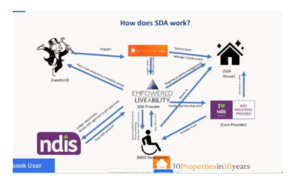Many people have recently asked me questions about the NDIS scheme and what it means for property investors.
I can understand their interest… I’ve been shocked to see ads promising 18% rental yields from NDIS-approved builds. You heard me right—18%! It seems too good to be true… surely the NDIS scheme is not a license to print money?
Let’s dive behind the big shiny promises and look at what’s really going on.
What Exactly Is NDIS and What Does It Do?
NDIS is an insurance model created to consolidate all the different disability systems across Australia into one central system.
One of the main roles of NDIS is to regulate and provide housing for people living with disabilities across Australia.
- Currently, there are about one million people within the NDIS.
- Among this population, only 6% are eligible for full care.
- The pool of people under the NDIS who have been placed in housing is around 130,000 people across Australia—which is a significantly low number compared to the NDIS available houses.
What The NDIS Housing Market Looks Like
While the promise of 18% returns seems like an exciting opportunity for property investors, the reality of the numbers speak a different story. Sydney and Melbourne are actually leading with high numbers of vacancies in NDIS housing compared to other cities across Australia.
So, why is this happening?
The drop in occupancy in Sydney, Melbourne, and other areas like Queensland is because when people leave these houses, it often becomes difficult getting other tenants in.
You probably know that if you want to win in the rental game, then you need to ensure your property is tenanted for a long time.
18% Rental Yield? Let’s Take A Closer Look
Now, some operators are claiming to get an 18% rental yield from investing in NDIS-approved housing. So the question is, “How do they get this huge return given houses designed with disabled tenants in mind are highly specialised and don’t suit everyone?”
Frankly I don’t see how the math adds up, especially for the average investor that doesn’t have specialised knowledge about building within the NDIS guidelines. The expenses of these builds are very high, and when you factor in sectors like robust housing, the cost of damages created by the tenant can be catastrophic to your bottom line.
With NDIS:
- You spend more on construction since you’re required to add special features.
- You can’t mix-match anything to save on cost.
- You must meet the minimum acceptable standards—you miss them, you won’t get tenants.
- If you want to attract good quality, long term tenants, the quality of your build and fixtures must be high, meaning the initial outlay is significant.
Let’s face it.
With all these factors working against you, the truth is you won’t get any return near 18%. It’s unreasonable. The maximum rental yield that you can expect should be 8.3%.
Something else…
… when you build NDIS houses, you incur a huge cost, making the rental rates very high. It becomes difficult to get tenants immediately. So, in your cost, you should budget for vacancies because it’s impossible to get a constant flow of tenants when one leaves. That’s another cost that eats away at the promise of 18%.
I’ve Received An NDIS Property Offer In Queensland, What Should I Do?
Simple answer. Run for the hills if someone tries to sell you NDIS property in Queensland. This is because there is an oversupply of NDIS housing in Queensland compared to demand.
Which is probably why you’re receiving the offer in the first place – someone wants to offload their money-pit to you!
Besides, inmost of the houses you’ll find in Queensland, you’ll need to invest an extra $50K that won’t go into bank valuation to modify or renovate the property. Do you hear that sound? It’s the sound of your hard earned money circling the toilet!
The Truth About NDIS Property Investing
The first thing you need to understand is that NDIS is complex, and it requires specialist knowledge to develop and manage these properties.
Can you make money with NDIS housing? Yes you can. Can you make 18% yields? I’d have to see it to believe it. And even then, I’m betting it’s a one-off from an investor with 20 years experience in that particular field.
Frankly, it’s not for the beginner investor.
If you are going to try it, a few words of advice –
- Be wary of the returns that NDIS housing investment ‘experts’ promise.
- Ensure you know the codes and guidelines of NDIS builds inside and out to make sure your property meets the minimum requirements.
- Factor in a portion of your budget to build housing that people would actually want to live in – if you skimp on quality and build dark and depressing houses, you will not attract good tenants and you will lose money.
- Ensure the buildings are certified and meet the national construction code—you need a certified assessor to help you with this.
- Ensure you get an NDIS provider audited and compliant with SDA guidelines. An audit takes months and months of paperwork for the NDIS provider. A good manager will charge you between 24-35%.
- Understand that NDIS provides no guarantee, and unless a tenant moves into the building, you can expect no returns.
Here is a chart to demonstrate how NDIS properties work. As you can see, it’s a complex way of investing in property.


What It Takes To Be A Successful NDIS Property Investor
It takes over 17 years of experience to be an expert in disability property. First, you have to get the NDIS property participants—landlord, NDIS, SDA, tenants, and registered provider—to work together. If anyone among them doesn’t fit, it doesn’t work.
So, if you’re new to property investment, I wouldn’t advise you to try it. It’s only for experienced and complex investors. This is because:
- It’s a speculative and high-risk investment.
- Getting tenants is a huge hustle.
- The return rates fluctuate easily.
- Getting a bank loan for NDIS property is not easy.
- There is an oversupply of NDIS properties, especially in Queensland.
So, What Next?
Do your due diligence when you think of investing in NDIS or any other property. Don’t fall into the trap of false ads that promise a fortune.
For me, I’ll stick to my Markoski Method™ of investing in areas where you’ll receive great capital growth and attract quality tenants that are happy to pay good money to live there.
If you want to find out more about how we help our clients invest in the right properties, in the right areas, at the right time (and start generating growth and cash-flow within days of closing the deal), we’d love to help you get started.
Let’s have a quick chat to assess your goals and your current financial situation and to see if we can help you. Click this link to book a 15 minute ‘getting to know you’ appointment with our coaches.
https://george.property/charmainepgp
If you’re not quite ready to take the step yet, but you want to get your ducks in a row for when you’re ready to get into property our 14 Day Positive Property Challenge is the way to go.
Over 2 weeks I personally guide you to create a blueprint for getting your first, second, third, fourth (and beyond) property. So when you’re ready to push the ‘go’ button on your plans, you’ll have everything ready and be crystal clear on what to do.
Click here to find out more about the 14 Day Live Positive Property Challenge




